Ever faced the menace of wood rot? Discover how a common household item, bleach, might be your saving grace!
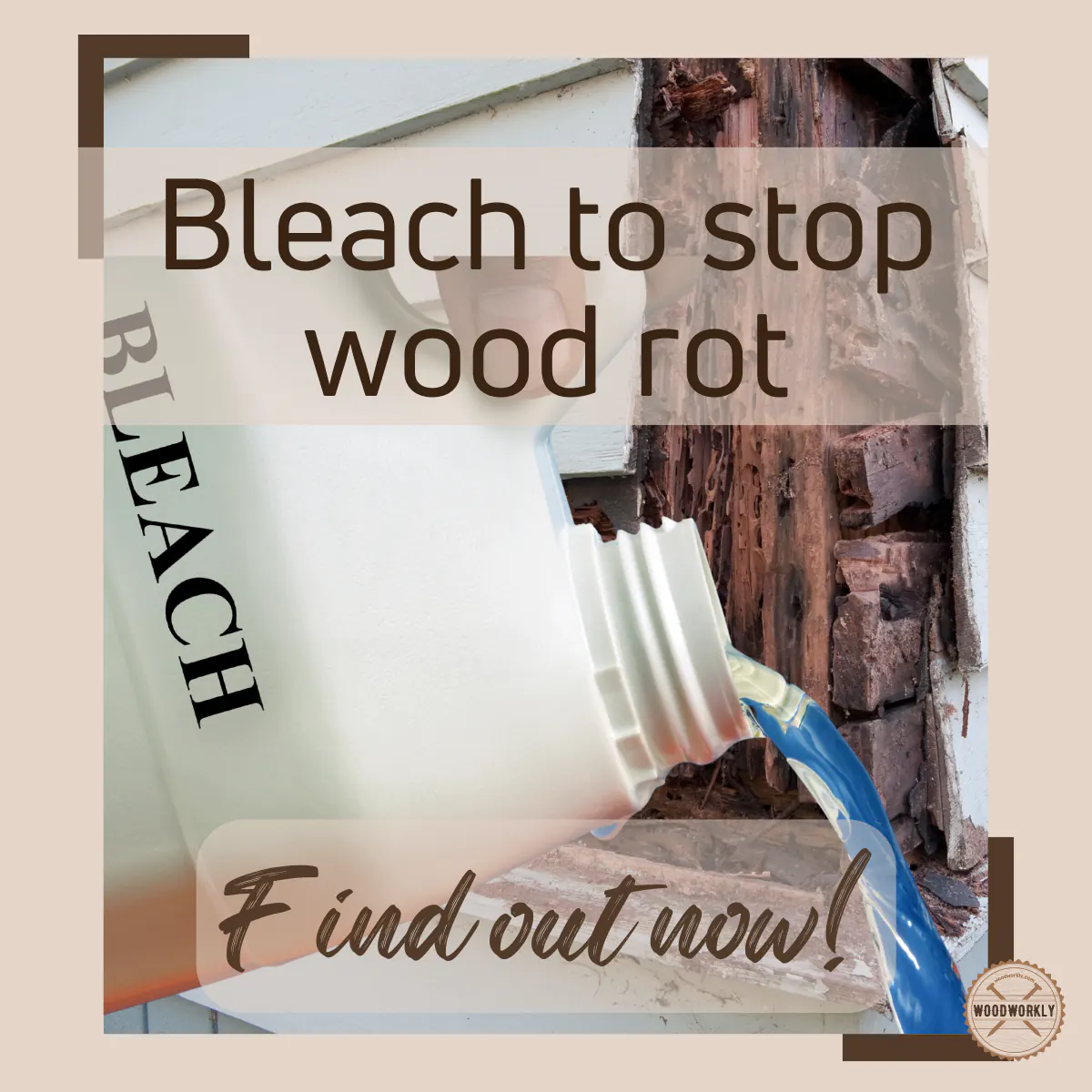
For a long time, I have experienced wood rot in my workpieces. This issue can potentially damage the furniture and incur high costs for repairs.
Given that many individuals are eager to learn methods to stop the rotting as quickly as possible.
Rot is one of my biggest issues for wood, mainly wet or dry rot. So, I think it’s worthwhile to know the different ways to stop wood from rotting, just in case.
I was curious to determine if bleach could prevent wood from rotting. Therefore, I conducted some research using bleach and found the answer I was seeking.
So, Let’s find out, Will bleach stop wood rot?
Yes, bleach keeps wood rot from getting worse and coming back. It is an affordable way to treat wood rot that works well. Just put two coats of bleach on the rotted wood and the wood around it. I make sure that coated wood stays dry because it works better.
But that’s just a quick snapshot of the question!

In this article, I’ll teach you how to use bleach to stop wood from rotting, plus other means to stop wood from rotting, and ultimately, how to stop wood from rotting in the first place.
Let’s dive right in!

Can Bleach Stop Wood From Rotting?
Yes, bleach is able to stop both dry rot and wet rot in wood. I always apply it on wood that isn’t vulnerable to the elements, like indoors or under the roof, since that’s where it works ideally.
Mold and mildew on the outer layer of the wood can be killed and cleaned off with bleach.
I usually, use it on wood that is coated with a preservative. These preservatives reduce their impact gradually, so if you ignore the issue, it will come back.
Bleach can’t stop wood from rotting after it starts happening.
I realized that there was already wood rot in the structure.
Due to this, I only apply bleach for the first round of cleaning since it isn’t able to get into the deeper parts of the wood.
Read to know, How to Tell if Wood is Rotten (Quick and Easy Fix!)
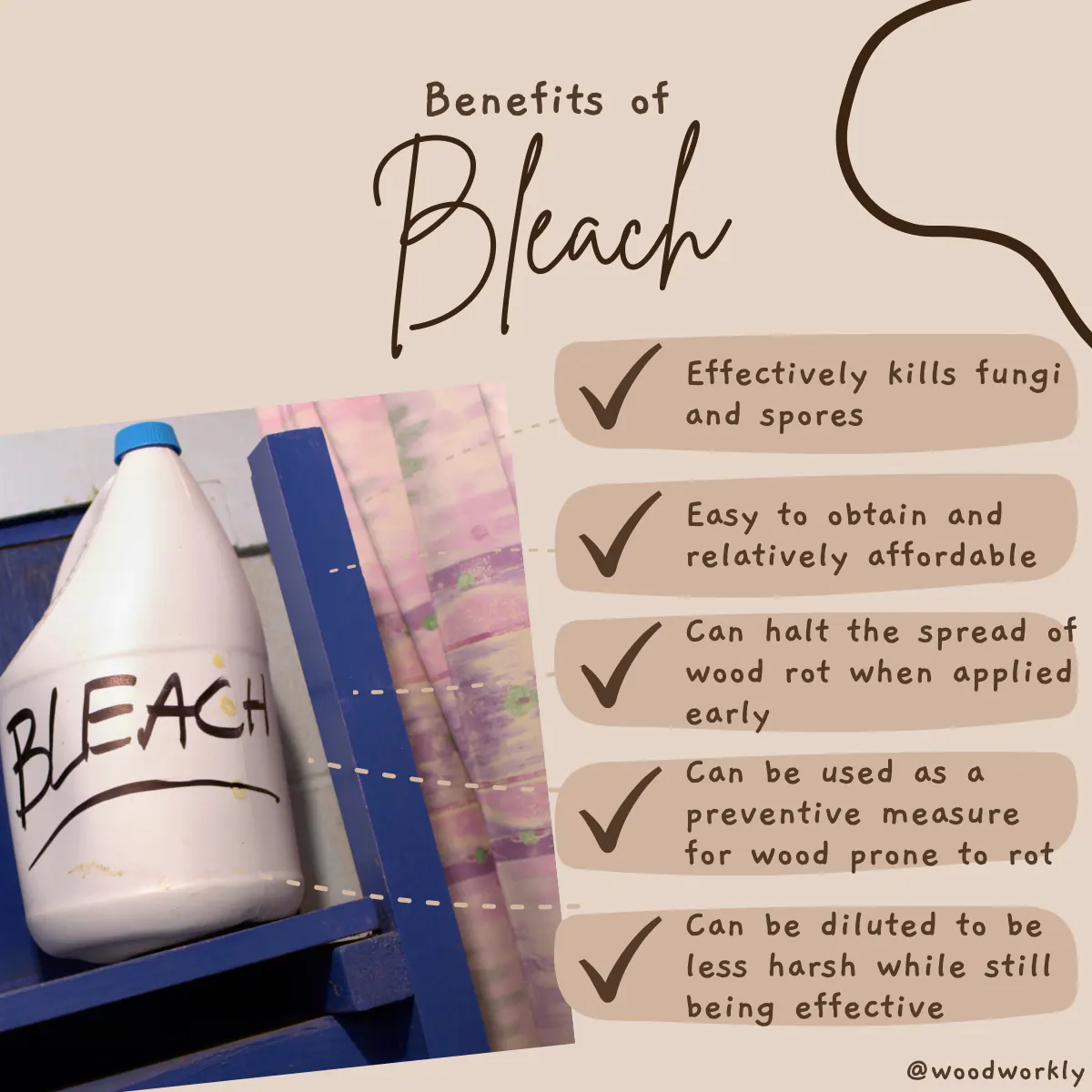
Types of Wood Rot
Why does wood rot? I believe knowing wood rot is the key to managing it well. The rot starts when too much water gets into the wood.
Due to this, wood-eating fungi and bacteria can get into the wood and eat its cells.
As it is eaten, fungus spores grow and spread looking for more wood, leaving indications of rot damage.
Do you know the main types of wood rot? Learning each type of wood rot helps you select the best way to handle it.
Here are the main types of wood rot,
- White Rot Or Wet Rot
- Brown Rot
- Dry Rot
Let’s have a look at each of those types of wood rot in detail.
White Rot or Wet Rot
Wet rot needs plenty of water, possibly 50%, to spread and take over wood.
Why Does White Rot or Wet Rot Happen?
Wood with excessive moisture gradually causes wet rot.
The cause of this wood’s wetness can vary, but as long as it stays the same, fungus spores can consume the lignin and make the wood rotten.
What Does White Rot or Wet Rot Look Like?
I have noticed that wet-rotted wood spots will appear darker than the rest.
Wood can seem shrunken and feel fragile and spongy with fragile cracks. Fungus and a damp smell like rotting soil help wet rot.
Treatment for White Rot or Wet Rot
Here is how to treat white rot,
- Find and fix dampness
- Scrape and put fungicide
- Dry and treat unaffected wood
- Replace highly damaged boards
Now let me explain these steps further.
1. Find and Fix Dampness
Fix the moist cause. I usually check the damage and separate the rotting wood if possible.
2. Scrape and Put Fungicide
I scrape rotten wood and apply wet rot fungicide. Wet rot is destroyed and maintained by this fungicide.
3. Dry and Treat Unaffected Wood
When putting another coat, I ensure the wood absorbs and dries. To avoid wood rot, handle the unaffected wood.
4. Replace Highly Damaged Boards
I change highly damaged boards with pre-treated ones. When the project is too big to DIY, hire a pro.

Brown Rot
Many woodworkers like me call it “brown” rot, but this wood-destroying fungus has many colors.
Why Does Brown Rot Happen?
Wet rot fungus feeds on sugars and cellulose in certain wood types that can’t digest lignin, causing brown rot.
What Does Brown Rot Look Like?
This makes rotting wood brown, like the damaged wood. I have seen brown rot staining soften wood, leading it to crumble and crack.
Treatment for Brown Rot
Here is my method of treating brown rot,
- Find and remove moisture
- Remove damaged wood
- Fully dry the area
- Put brown rot fungicide
- Check and prevent
- Replace very damaged wood
Let me explain this method further with these steps.
1. Find and Remove Moisture
First I fix the leaks or extreme humidity causing brown rot to avoid fungus development.
2. Remove Damaged Wood
Then I remove any obvious rotting wood, even compromised places.
3. Fully Dry the Area
Using ventilation and dehumidification to I dry out the treated part and prevent brown rot.
4. Put Brown Rot Fungicide
To stop reinfection I use a brown rot-specific fungicide advised by the producer.
5. Check and Prevent
Keep moisture control and I check for brown rot recurrence to prevent more infestations.
6. Replace Very Damaged Wood
To improve and prevent decay, replace weakened wood with pre-treated or just-treated wood.
I always inspect for brown rot recurrence and use long-term moisture control to prevent new infestations.

Dry Rot
Dry rot fungus needs 20% wood moisture to germinate and colonize. Dry rot will consume wood once it dries out, unlike other types.
Why Does Dry Rot Happen?
A minimum of 20% moisture is required for dry rot fungus to flourish in wood.
What Does Dry Rot Look Like?
Dry rot symptoms are white cotton wool on the wood surface. I have seen almost progressed dry rot create cuboidal cracking—tiny square patches of wood.
Once the rot is progressed, mushroom-like fruiting bodies develop among the fungal spores.
Once the fungus devours all the fresh wood, the wood
Treatment for Dry Rot
This is my way of treating dry rot in wood,
- Remove and prepare wood
- Clean and remove growth
- Use dry Rot treatment
- Treat surfaces and manage moisture
Now I’ll teach you exactly how this method works.
1. Remove and Prepare Wood
Rotted wood must be removed. First I remove the rotten wood and some inches of sound wood beyond its final fungus growth.
2. Clean and Remove Growth
Next, remove fruiting bodies, hyphae, mycelium, and obvious fungus spores. Then, I scrub the wood and surrounding wall using a firm brush to eliminate surface growth.
3. Use Dry Rot Treatment
I always apply dual-purpose dry rot treatment solution freely on fresh and old wood. This unique fungicide kills dry rot spores while preventing future wood rot.
4. Treat Surfaces and Manage Moisture
Two coats of fungicide on surrounding masonry or concrete are plenty. I normally use a dehumidifier and ventilate to clear moisture from the wood.
Read to know more about wet rot and dry rot.
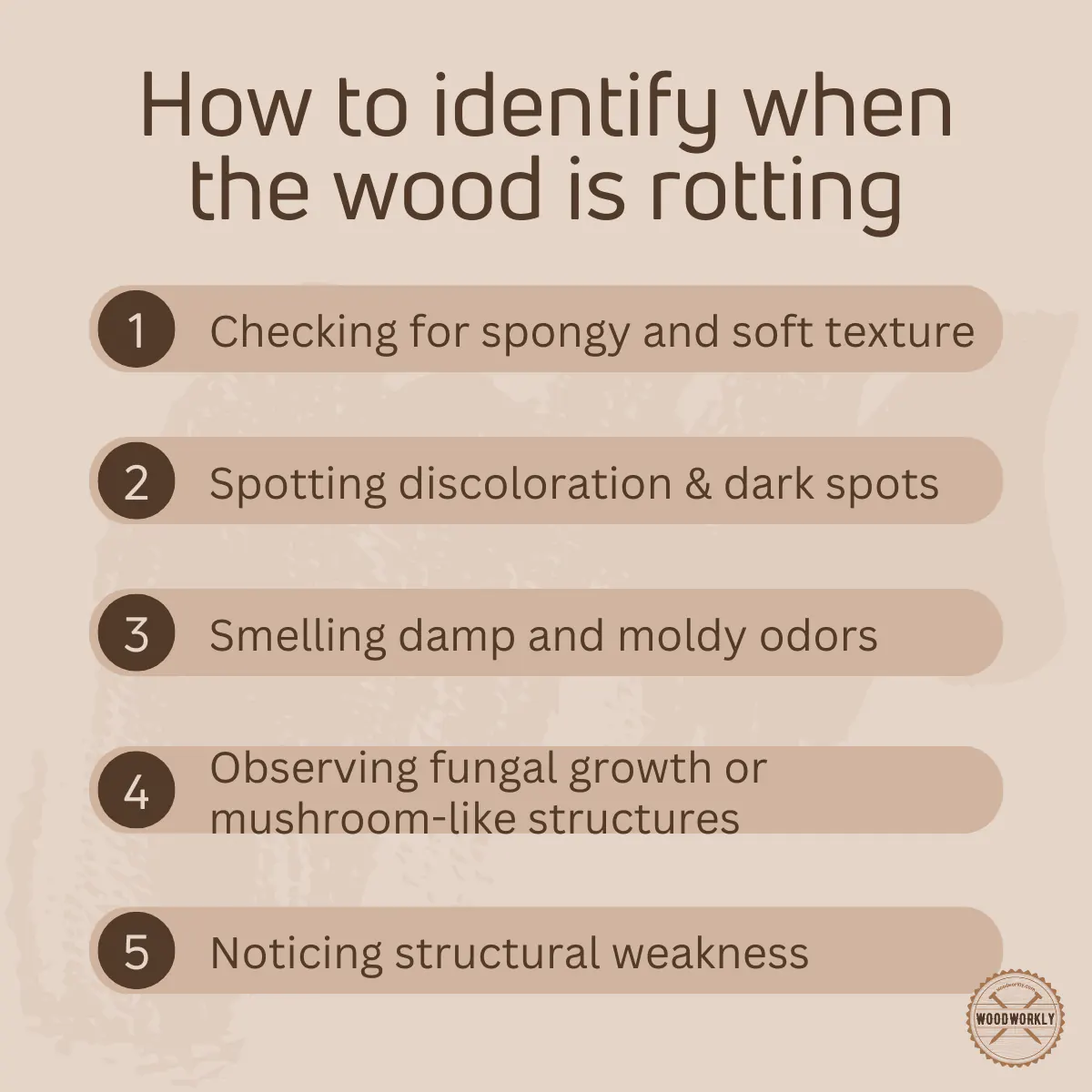
Now Let’s look at the correct procedure of stopping wood rot using bleach. First, you need to collect the following supplies.
Supplies You Will Need When Stopping Wood Rot Using Bleach
Here is what you’ll need:
- Chlorine Bleach
- Gloves
- Mask
- Protection Goggles
- Wood Fillers
- Wood Finish
- Brush
- Sanding Paper
- Hot Water
- Cotton Swab or Spray Bottle
- Putty Knife
Collect the above supplies from quality manufacturers and get ready to stop wood rots using bleach without messing things up.
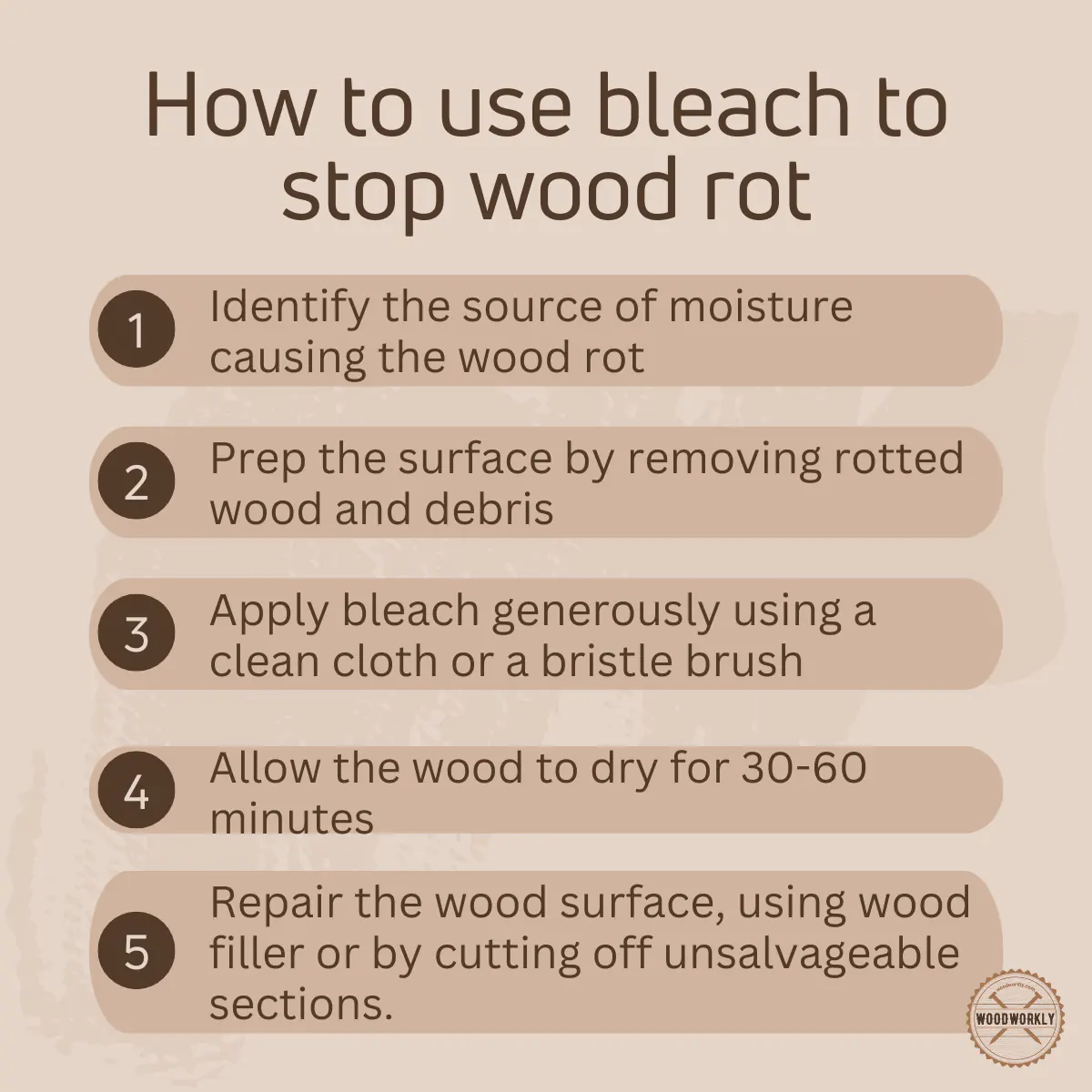
How To Stop Wood Rot Using Bleach
Want to know how to stop wood rot using bleach?
Bleach removes wood fungus and prevents re-growth. I recommend using Chlorine bleach to reduce rot spots and brighten wood.
Now let me show you how to stop wood rotting with bleach,
- Find the main moisture source
- Preparing wood for bleaching
- Put bleach on the rotted spot
- Putting wood filler and finishing coat on holes/cracks
- Keep the wood in top shape
Now let me go into more detail about my method of stopping wood rotting with bleach.
1. Find the Main Moisture Source
First I look for washing machine leaks or cracked piping to find the dampness.
Leaking windows plus other house systems may cause water harm besides to the laundry room.
Use gloves and fix leaks after locating the cause. Using a humidifier will likewise dry up the affected area.
2. Preparing Wood for Bleaching
Replace core-rotten wood parts with pre-treated boards.
I remove decaying areas with a chisel and brush and keep fixable sections.
3. Put Bleach on the Rotted Spot
Afterward, I put chlorine bleach in a clean container. Dip a cotton rag in weak chlorine bleach later.
Use the solution and rinse the bleach using warm water before drying.
4. Putting Wood Filler and Finishing Coat to Holes/Cracks
When repairing the wood, fill fungal extraction spaces. I typically use polyester or epoxy wood filler.
Because fillers shrink after drying, use generously.
5. Keep the Wood in Top Shape
Maintaining the workpiece from rot is necessary after removing rotting wood parts.
In humid climates, ventilation or a humidifier is required to maintain surfaces dry.
Tips for Using Bleach To Stop Wood Rot
Bleach helps prevent wood rot, but use it carefully.
Here are some of my best tips to use when using bleach to stop wood rot.
- Safety Comes First: Before starting, wear gloves and eye protection while working in a well-ventilated spot to prevent breathing fumes.
- Find Affected Places: I always establish the wood rot severity. Knowing the issue’s extent is crucial before bleaching.
- Create Bleach Solution: I mix bleach with water. This mixed bleach solution is safer to use.
- Try a Tiny Portion: Before fixing the whole affected place, I simply check the bleach mixture on a tiny, unnoticeable part of wood to guarantee no discoloration or harm happens.
- Use the Solution: Put bleach to afflicted wood with a brush or sponge. I ensure that the wood is saturated.
- Let It Rest: I just wait 15-20 minutes for the bleach mixture to penetrate the wood. This kills rot-causing fungus.
- Scrub and Rinse: After waiting, I only use a stiff brush to eliminate weakened, rotting wood. Rinse bleach residue carefully with clean water.
- Look for Reoccurrence: I normally keep an eye out for rot in managed wood. You might have to repeat the bleach method or make larger fixes.

Bleach Alternatives to Stop Wood Rot
Did you know that there are other alternatives you can use to stop wood rot?
Like bleach, there are different solutions that can be used to stop wood from rotting that work just as well.
In my opinion here are the bleach alternatives that I use sometimes to stop wood rot:
- Ethylene Glycol
- Boric Acid (Borate)
Let me tell you more about what these solutions can do,
Ethylene Glycol
Despite the fact that Ethylene Glycol is harmful, it can easily get into the fibers of wood and kill bacteria.
It continues to be on the surface and stops rotting from taking place once again.
Boric Acid (Borate)
Boric acid is commonly used to make wood stronger and stop the rotting process from getting more serious and spreading to the surface.
Borate solutions additionally stop wood from getting rotten as time goes on.
Treatment to Avoid Wood Rot
Do whatever you can to keep fungi spores from creating a base in your home before you enter the wood rot repair club.
Here’s how I get through it:
- Use Rot-Resistant Wood Types: I suggest choosing oak or redwood, which don’t rot quickly.
- Consider Placing in Proper Ventilation in High-Moisture Spots: For dry and cooler airflow, spots like bathrooms and washrooms I have air vents and exhaust fans.
- Keep Downspouts and Gutters Away from outside Wood: I always keep outdoor wood pieces far from gutters or outlets where water tends to gather.
- Don’t put the Wood Deep in the Ground: A deeper placement may let in more water, so the depth shouldn’t be more than 15 inches.
- Use Wood Preservatives: It doesn’t stop wetness, but the preservatives can stop decay and rot.
- Set up a Dehumidifier to Remove Moisture: I use a dehumidifier to keep a space dry makes it less likely that wetness will build.
Whether bleach can prevent the wood from rotting or not depends on how bad the wood is.
I recommend taking measures instantly as you see any sign of rotting, regardless of how small.
After all, you don’t want the repair job to escalate into an expensive board-replacing job.
Congrats folks! Now you exactly will bleach stop wood rot and how does it do that in detail.
If you don’t have access to bleach, Don’t worry! You can also use the Flex seal to stop wood from rotting!
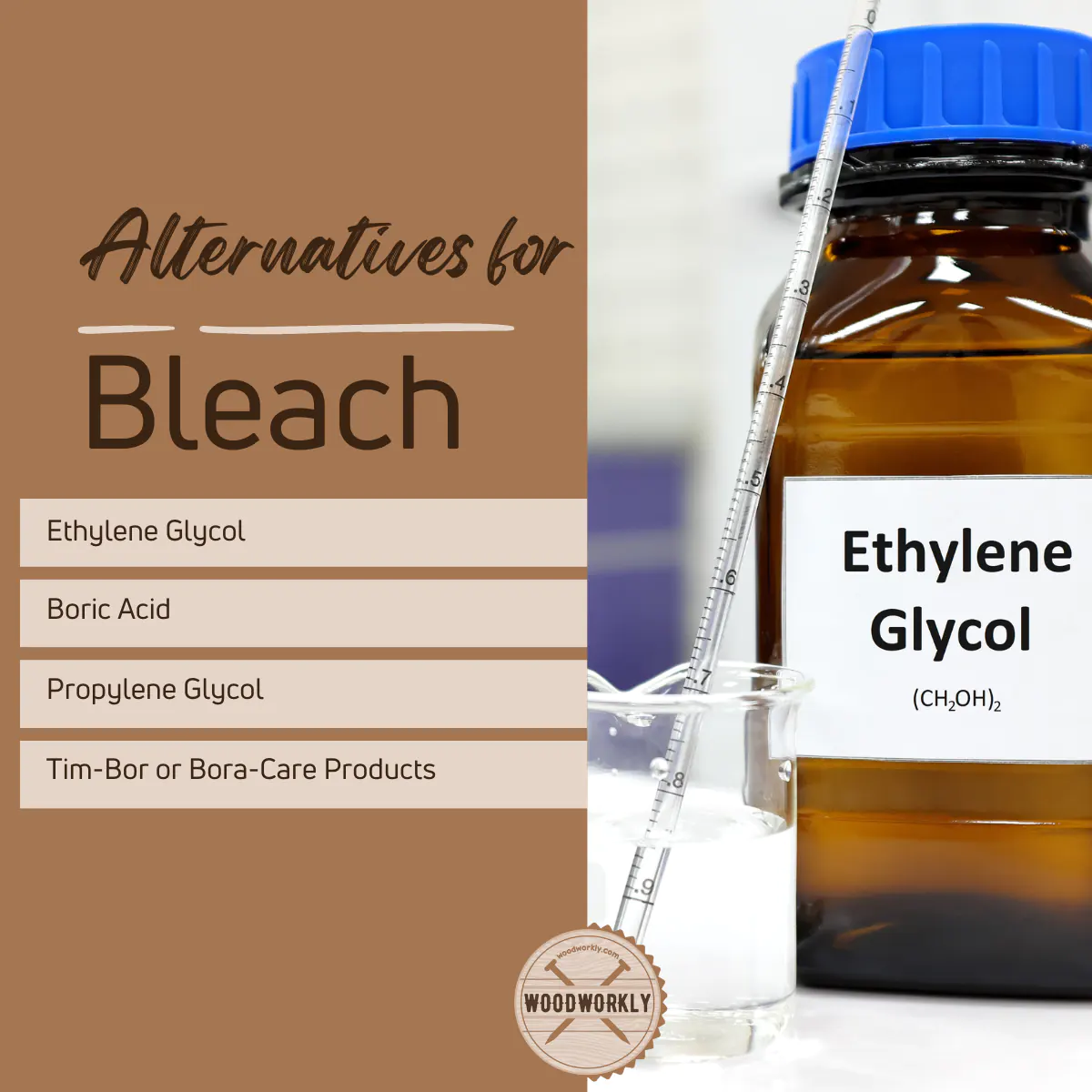
So, let’s answer some frequently asked questions.
FAQs
Can I Use Any Kind of Bleach to Stop Wood Rot?
Yes! you can use any kind of bleach to stop wood rot. While chlorine bleach is most commonly used owing to its excellent fungus-fighting properties, oxygen bleach can also be a great alternative that is less harsh on your wood.
How Does Bleach Help in Stopping Wood Rot?
Bleach effectively kills the fungus causing the rot, it’s like a superhero swooping in to save the day. Just apply it to the affected areas and witness the magic unfold!
Can Bleach Prevent Further Wood Decay?
Yes, Bleach can prevent the wood from decaying furthur. Applying bleach not only stops the existing rot but forms a protective layer, acting like a shield against future invasions of rot-causing fungi.
Is it Necessary to Dilute Bleach Before Applying it on Wood?
Not necessarily! While diluting bleach can make it safer, using it undiluted gives a potent punch to stubborn fungus, sending them packing in no time.
Can I Apply Bleach on Finished Wood Surfaces?
You can apply bleach on finished wood surface, but with caution. Bleach might alter the color or finish, so doing a patch test in an inconspicuous area first is a wise move.
How Long Should I Let the Bleach Sit on the Wood to Treat Rot?
After applying bleach generously, let it sit for about 30 to 60 minutes to effectively eliminate the fungus and prevent future rot.
Are There Any Alternatives to Bleach for Treating Wood Rot?
Yes, You might explore options like ethylene glycol or boric acid, which penetrate deep into the wood fibers, wage war against fungal spores, and prevent future rot effectively.
Can I Use Bleach to Treat Different Types of Wood Rot, Including Dry and Wet Rot?
Whether it’s the dreaded dry rot or the pesky wet rot, bleach stands tall as a one-stop solution, ready to tackle them with full vigor.
What Precautions Should I Take While Using Bleach to Treat Wood Rot?
Safety first! Always don protective gloves, goggles, and a mask to safeguard yourself from bleach fumes and potential splashes during the application process.
Can I DIY the Wood Rot Treatment Using Bleach?
Yes you can DIY wood rot treatment using bleach. First, grab some bleach and a clean cloth, and get ready to bid adieu to the troublesome wood rot lurking in your lovely home!
Did I cover all you wanted to know about: Will Bleach Stop Wood Rot
In this article, I’ve deeply explored will bleach stop wood rot, different types of wood rots, and how to stop wood rot properly using bleach based on my own experience.
Bleach can effectively stop wood rot by eliminating the fungus responsible for the decay. It is easy to use and readily available, making it a popular choice for treating both wet and dry rot. It’s advisable to address the root cause of the moisture problem to prevent future occurrences.
Furthermore, I’ve answered some frequently asked questions.
Apart from stopping wood rot, you can also use bleach to neutralize the red color on the wood and to neutralize the orange color on the wood.
Hope you’ve learned everything you wanted to know about, Will bleach stop wood rot from an expert’s perspective.
Now it’s time to give bleach a try and stop your loved furniture from being damaged due to evil wood rot.